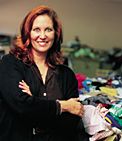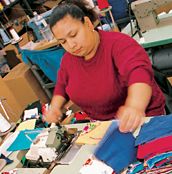 |
 |
||||||
|
|
|
|
.
|
ANGELA HAWKINS ('95) ADMITS SHE'S A "SHOPAHOLIC," especially when it comes to clothes. “I shop a lot,” confesses Hawkins. “It seems like whenever I’m anywhere near a store that has nice clothes, I have to go in to take a look. And very often I come out with something new.” Presently, she has clothes overflowing three closets, numerous drawers and several storage boxes. She says she knows it’s time to get rid of things when she can’t get into her closets anymore. Her first reaction is to give some of her excess clothing to charities or relatives, but she has to admit that she throws away a lot of old clothing and rags. Hawkins is not alone. Current research indicates that the average American throws away 67.9 pounds of clothing and rags each year. With some 20 million people in the state of Texas, that’s 1.4 billion pounds of clothing thrown away each year in Texas alone. However, there’s good news for Hawkins and for all of us — about 95 percent of our clothing throwaways are recyclable. And that potential drives UNT researcher Jana Hawley in a unique project that is aimed at making all Americans more aware of the reusability of textiles. Hawley, an assistant professor of merchandising and hospitality management who has worked and studied in the textile industry for 16 years, spent last summer collecting data from various textile recycling companies in Texas and around the nation to study and chart their recycling methods. She wants American consumers to realize the enormous volume — and value — of the garments they throw away. “Although many consumers enthusiastically recycle their aluminum cans, glass containers and plastic jugs, there’s no protocol for old clothes,” she says.
Best-kept secret Clothing recycling is one of the oldest forms of recycling, but it’s the least known. Hawkins and others have the right idea in taking clothing to charities, but many communities don’t know they can also order clothing recycling bins from for-profit companies. “The local company that maintains the city of Denton’s textile recycling bins takes in five to seven tons of clothing and rags each month,” says Joe Ialenti, Denton’s recycling manager. “And it’s a great source of income for the city. The company we work with pays us rent for the space.” Annually, textile recycling removes 2.5 billion pounds of consumer clothing waste headed for landfills. This is an average of 10 pounds per American, but it barely puts a dent in the amount that goes to waste. According to Hawley, about 145 billion pounds of recyclable clothing are still routed to landfills every year. She believes this national figure can be drastically lowered if more people go through the nontraditional methods of recycling clothes as well as donating to charities. Hawley has determined that the textile recycling industry is made up of used clothing dealers and exporters, and fiber recyclers. Most are small, family-owned businesses with fewer than 500 employees. They purchase clothes as “mixed rags” surplus from charitable organizations or work out agreements with cities to place collection bins at strategic locations. “We’re literally recycling about a million pounds of clothing each week,” says Thom Haxton, the vintage clothing specialist for Mid-West Textile Co. in El Paso — one of the largest textile recycling houses in the United States. “But even at that rate we estimate that we handle less than 1 percent of the nation’s surplus clothing because millions of pounds of clothing are still going to the landfills.”
A world of alternatives Almost half of the garments reclaimed by textile recyclers are exported to Third World nations to clothe the world’s poorest people. Hawley’s research shows that in many of these nations, secondhand clothing is all that is affordable to people who earn as little as $200 per year. According to Haxton, a pair of pants from the United States can be delivered to Africa and blouses can go to Pakistan for less than the cost of mailing a letter. These are markets that most charities don’t approach, but they are sustained partly by the excess that comes to recyclers from charitable organizations. Hawley says there’s also a specialized market for wearable vintage American clothing in wealthy countries such as Japan and France. Although only 1 percent of the clothes sorted by operations like El Paso’s Midwest Textile Co. are vintage and collectible items, they comprise about 15 percent of the revenues for most recycling houses.
Redone rags
In another aspect of textile recycling, old clothes are made into new items. Although American consumers aren’t as likely to buy new garments made from “waste materials,” recyclers say the practice is common in Europe. Outside the United States, wool and cashmere clothing is broken down into raw fibers and yarns for the manufacture of new garments. In the United States, it’s not uncommon for companies to take whole garments and redesign them into trendier new clothes. About 20 percent of used clothes gathered by textile recycling houses become wiping and polishing cloths sold to the government or industries for use in auto garages, furniture finishing and janitorial supply operations. Washable cloth rags are easier on the environment than disposable paper towels. Clothes ruined by stains or other damage are recyclable, too. They can be chopped into fine fiber called shoddy, a product used in mattresses, home and auto insulation, and filtration systems. Recycled fabric can also be shredded and refined for the aeronautics industry, used as roughage for cattle and used to strengthen plastics. Cotton rags can be chopped into shoddy for the paper industry. Some items still are not salvageable. About 2 to 3 percent of the materials that go to recycling houses end up in landfills. These items commonly include raincoats, plastic shower curtains, and pillows damaged beyond re-use. But research efforts like Hawley’s, which focus attention on the textile recycling industry, may eventually help recyclers find uses for even the most unsalvageable materials.
Conscious change Bernie Brill, executive director of the Council for Textile Recycling, says he hopes Hawley’s study will build greater consumer awareness about recycling. “Awareness is the biggest barrier stopping communities from starting their own textile recycling programs,” he says. Simple
awareness already is helping Hawkins to change her behavior. “This
has just given me a new cause,” she says. “I had no idea that practically
everything was recyclable. I’m definitely going to start passing
more things along and stop throwing reusable things away.”
|
||||||||||||||


